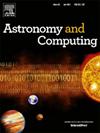Formation of S2 species in different redox states by radiative association in atomic and ionic collisions
IF 1.8
4区 物理与天体物理
Q2 ASTRONOMY & ASTROPHYSICS
引用次数: 0
Abstract
Radiative associations for formations of the S2, S2+ and S2- molecular species during atomic collisions S(3Pu) + S(3Pu), S(3Pu) + S+(4Su) and S(3Pu) + S-(2Pu) are investigated. The adiabatic potential energy curves (PECs) and spin-allowed transition dipole moments (TDMs) are obtained by the internally contracted multireference configuration interaction method with the Davidson correction (icMRCI+Q). A number of PECs and TDMs are chosen to calculate the corresponding cross-sections and rate coefficients of radiative associations. The calculated rate coefficients are valid for the temperatures from 100 to 16000 K and fitted to the analytical function according to the three-parameter Arrhenius–Kooij formula. These results indicate that transitions originating in the ΔΛ=0 selection rule are the main contributors for the radiative association process. The present study can elucidate the further understanding the radiative association, which plays an important role in the formation and evolution of the S2, S2+ and S2- molecules.
在原子和离子碰撞中通过辐射关联形成不同氧化还原态的 S2 物种
研究了原子碰撞 S(3Pu)+S(3Pu)、S(3Pu)+S+(4Su)和 S(3Pu)+S-(2Pu)过程中形成 S2、S2+ 和 S2- 分子物种的辐射关联。绝热势能曲线(PECs)和自旋允许的过渡偶极矩(TDMs)是通过戴维森校正(icMRCI+Q)的内部收缩多参量构型相互作用方法获得的。选择一些 PEC 和 TDM 来计算辐射关联的相应截面和速率系数。计算出的速率系数适用于 100 至 16000 K 的温度,并根据三参数 Arrhenius-Kooij 公式拟合到分析函数中。这些结果表明,源自 ΔΛ=0 选择规则的转变是辐射关联过程的主要贡献者。本研究可进一步阐明辐射关联在 S2、S2+ 和 S2- 分子的形成和演化过程中的重要作用。
本文章由计算机程序翻译,如有差异,请以英文原文为准。
求助全文
约1分钟内获得全文
求助全文
来源期刊

Astronomy and Computing
ASTRONOMY & ASTROPHYSICSCOMPUTER SCIENCE,-COMPUTER SCIENCE, INTERDISCIPLINARY APPLICATIONS
CiteScore
4.10
自引率
8.00%
发文量
67
期刊介绍:
Astronomy and Computing is a peer-reviewed journal that focuses on the broad area between astronomy, computer science and information technology. The journal aims to publish the work of scientists and (software) engineers in all aspects of astronomical computing, including the collection, analysis, reduction, visualisation, preservation and dissemination of data, and the development of astronomical software and simulations. The journal covers applications for academic computer science techniques to astronomy, as well as novel applications of information technologies within astronomy.
 求助内容:
求助内容: 应助结果提醒方式:
应助结果提醒方式:


